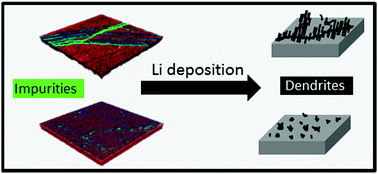The effect of local lithium surface chemistry and topography on solid electrolyte interphase composition and dendrite nucleation†
Abstract
With more than 10 times the capacity of the graphite used in current commercial batteries, lithium metal is ideal for a high-capacity battery anode; however, lithium metal electrodes suffer from safety and efficiency problems that prevent their wide industrial adoption. Their intrinsic high reactivity towards most liquid organic electrolytes leads to lithium loss and dendrite growth, which result in poor efficiency and short circuiting. However, the multitude of factors that contribute to dendrite formation make determining a nucleation mechanism extremely difficult. Here, we study the intricate science of dendrite nucleation on metallic lithium by using an array of analytical techniques that provide simultaneous ultra-high spatial sensitivity and chemical selectivity. Our results reveal a 3D picture of the chemical make-up of the native Li surface and the resulting solid electrolyte interphase (SEI) with better than 200 nm resolution. We find that, contrary to the general understanding, the initial surface chemistry, not the topography, is the dominant factor leading to dendrite nucleation. Specifically, inhomogeneously distributed organic material in the native surface leads to inhomogeneously dispersed LiF-rich SEI regions where dendrite nucleation is favored. This has significant implications for battery research as it elucidates a mechanism for inhomogeneous SEI formation, something that is accepted, but not well understood, and highlights the importance of Li surface preparation for experimental studies, which is implicit in battery research, but not directly addressed in the literature. By homogenizing the initial lithium surface composition, and thus the SEI composition, we increase the number of dendrite nucleation sites and thereby decrease the dendrite size, which significantly increases the electrode lifetime.



 Please wait while we load your content...
Please wait while we load your content...